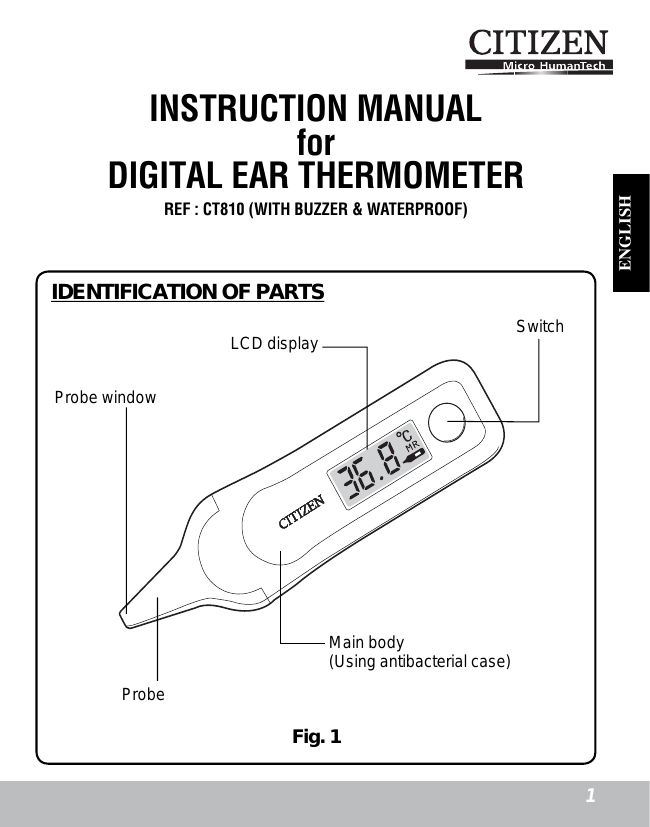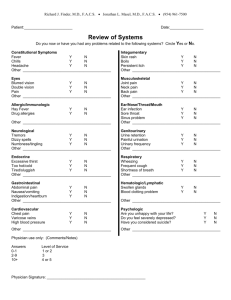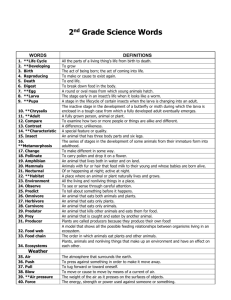INSTRUCTION MANUAL for DIGITAL EAR THERMOMETER
advertisement

ENGLISH INSTRUCTION MANUAL for DIGITAL EAR THERMOMETER REF : CT810 (WITH BUZZER & WATERPROOF) IDENTIFICATION OF PARTS Switch LCD display Probe window Main body (Using antibacterial case) Probe Fig. 1 1 Warning PLEASE READ THIS MANUAL IN ANY CASE BEFORE USING. ENGLISH PRECAUTIONS The ear thermometer must be inserted correctly to obtain correct temperature measurement. Be sure to consult a physician if you feel something is wrong with you. Do NOT judge only by whether you have a fever or not. 1. Very gently and carefully insert the probe into the ear. 2. Avoid using the ear thermometer if the ear is inflamed. 3. Do NOT use the ear thermometer if the main body is damaged (for example, the probe window is broken). The continuous use of damaged unit may cause injury, an improper result or serious danger. Contact a physician immediately if someone swallows broken pieces. Caution 1. The body temperature measured in the ear may differ from the measurement under the armpit or in the mouth or rectum. Therefore, they cannot merely be compared. Take the temperature periodically to determine the reading with this instrument when body temperature is normal, then use that as the basis for comparison with any measurement taken when you suspect a fever. 2. Do NOT use this thermometer for measurements other than body temperature. The ear thermometer will be damaged if it is used to measure the temperature of bath, refrigerators etc. 3. Do NOT immerse the ear thermometer in Water and do NOT spill chemical solvents on the unit. 4. Do NOT drop the ear thermometer and do NOT expose the ear thermometer to heavy shock. As the ear thermometer is not shockprotected construction. 5. Do NOT bend the ear thermometer. 6. Do NOT disassemble the unit, do not make any modifications and do not touch the circuitry. 7. Do NOT store the unit under the direct sunlight, NOT at the high temperature and NOT at a high degree of humidity or dust. 2 ENGLISH 8. Do NOT boil the probe. 9. Do NOT use the ear thermometer if it operates irregularly or shows sings of malfunction. 10.Do NOT use thinner or benzene for cleaning the ear thermometer. 11.When using the ear thermometer after storage at low temperature, place it in a warm place for 5 to 10 minutes before use. 12.Keep the ear thermometer out of reach the children. 13.Wipe the ear thermometer clean before storing. About Ear Thermometers All objects radiate heat. To measure body temperature, this ear thermometer uses an infrared sensor incorporated in its probe to detect the heat radiated from the eardrum and its periphery. In general the ear canal (external auditory canal) of an infant is relatively straight. As we grow older, it takes on some curvature, as shown in Fig. 2. It is important to point the probe window of the ear thermometer toward the eardrum and its periphery inside the ear. To straighten the ear canal, gently pull on the outer ear in the direction of the rear of the head, as shown in Fig. 3. Each ear canal has a slightly different shape. Be sure to check it before measurement. And then insert the prove straight, as shown in Fig. 4. Fig. 2 Fig. 3 Fig. 4 3 Caution ENGLISH 1. A person’s left and right ear canals are not necessarily symmetrical. This may cause different measurement results. Always take temperature in the same ear. 2. A soiled probe window will result in inaccurate measurement. Be sure to check that the probe is clean before use. 3. Body temperature rises after vigorous exercise, a bath or shower, or eating. Wait at least 30 minutes before measuring temperature. 4. Do NOT use the ear thermometer when the ear canal is wet (after swimming, bathing, etc.). 5. Let the ear thermometer stand at room temperature for a while before use. 6. It is important to know your normal temperature to compare measurement result. HOW TO OPERATE / MEMORY FUNCTION 1. Confirm that the probe window is clean. 2. Pressing the switch generates a short beep. Confirm that the display shows all indicators lit (Fig. 5), the previous measurement result (for approx. 1 second, Fig. 6), then the “Start measurement message ” will be displayed (as Fig. 7). Fig. 5 Fig. 6 3. Hold the outer ear and gently pull it toward the rear of the head to straighten the ear canal (Fig. 3 and 4) 4. Hold the ear thermometer as shown in the illustration (Fig. 8). Point the probe window toward the inside of the ear. Insert the probe VERY GENTLY and SLOWLY into the ear canal. 4 Fig. 7 Fig.8 If the ambient temperature is 35 ˚C or higher: To prevent the ear thermometer from measuring the ambient temperature, make sure that the power is turned off, then hold the switch pressed for at least 3 seconds. Still holding the switch pressed, insert the probe into the ear, then release the switch. Caution 1. Small children must not operate this instrument, and it must be kept out of their reach. Be sure that body temperature is measured by an adult. 2. The person whose temperature is to be taken must not move his/her head while the probe is being inserted into the ear. 3. Once a measurement is taken, the temperature in the ear is affected. Therefore, wait at least 1 minute before taking next measurement. AUTO POWER OFF FUNCTION If this unit is left on after measurement, an Automatic Power-OFF Function turns the power OFF after approximately 1 minutes. 5 ENGLISH 5. The measurement time is approximately 2 seconds. A short, double beep tells you that measurement is completed. The measurement result will flash on the display if the ambient (room) temperature is 35 ˚C or higher which means the measurement is not completed. In such a case, take the following steps to measure again. 6. Press the switch, and turn the power off. ENGLISH BATTERY REPLACEMENT 1. Replace with new battery if the battery indicator ( ) lights up when the switch is pressed. 2. Use a Phillips screwdriver to remove the screw. 3. Use a coin to rotate the battery cover in the direction of the arrow, then remove the cover. (Fig. 9) 4. Remove the old battery, and replace it with a new one. (Fig. 10) 5. Reinstall the battery cover, and retighten the screw. (Fig. 11) Fig. 9 Fig. 10 Fig. 11 (Be sure to orient the battery correctly) Caution 1. Remove then reinstall the battery if an error message is displayed, the display is abnormal, or nothing is displayed when the switch is pressed after battery replacement. 2. To protect the environment, dispose of the used battery according to local regulations. 3. Remove the battery if the ear thermometer will not be used for a long time. AFTER USE AND STORAGE - After use, clean the probe and probe window with cotton soaked in alcohol or wet tissue available on the market, then wipe with a dry cloth. - Storing the ear thermometer at 5 to 35 ˚C allows you to measure temperature at any time. Storing the ear thermometer below or above this temperature range above may cause it to display Error 4. In such a case, leave the ear thermometer at 5 to 35 ˚C for 10 minutes before measurement. 6 - Do not store the ear thermometer where it will be exposed to moisture, direct sunlight, high temperature or high humidity, or excessive dust. Do NOT store the ear thermometer soiled or moist. If the ear thermometer is soiled, take the following steps to clean it. 1. Use a soft sponge soaked in neutral detergent to lightly wipe dirt off the probe and probe window. 2. Rinse the ear thermometer in standing lukewarm water for less than 20 seconds to remove dirt and detergent. 3. Be sure to carefully dry the ear thermometer with a soft cloth. - Avoid using the ear thermometer for measurement immediately after washing. Wait at least 5 minutes before use. - Do NOT rinse the ear thermometer directly under strong water flow from a faucet. - Do NOT use a toothbrush, scouring sponge or pad, steel wool, cleanser, etc. to clean this instrument. DESCRIPTION OF DISPLAY MARK Error 1 This message will be displayed if the thermometer fails to make stable measurement of body temperature within 30 seconds. Insert the probe into the ear promptly after pressing the switch. Error 2 This message will be displayed if the switch is pressed with the thermometer in the ear. Be sure to press the switch and confirm that “Fig. 7 ( )” is displayed, then insert the probe into the ear for measurement. Error 3 This message will be displayed if the temperature measured is above 42 ˚C. The thermometer may have measured the temperature of a nearby heat source. Avoid external heat sources and try again. Error 4 This message will be displayed if the ambient temperature is out of the measurement range (below 5 ˚C or above 40 ˚C). Move to a place within the proper temperature range (from 5 to 40 ˚C) end let the thermometer stand for at least 10 minutes before measuring again. 7 ENGLISH CLEANING Replace with new battery if the low-battery-power Low battery indicator lights up nothing is displayed when the switch is power pressed. ENGLISH Questions and Answers Q1: Why is temperature measured in the ear different from the measurement result under the armpit or in the mouth or rectum? A1: Temperatures at different parts of body may differ. Compare the measurement in question with normal temperature previously taken in the same ear. Q2: Temperature differs each time I measure. Why? What can I do? A2: Your method for straightening the ear canal may be inconsistent, the way you insert the probe may be not consistent, or you are perhaps taking a second measurement too soon. Pull the outer ear rearward to straighten ear canal, then very gently insert the probe into the ear canal for measurement. Once a measurement is taken, the temperature in the ear is affected. Therefore, wait at least 1 minute before taking another measurement. Q3: Can I measure temperature without the probe cover? A3: This instrument is designed to measure temperature without the probe cover. Do NOT attach the probe cover or any film or covering. Q4: Is it hygienically all right to use the ear thermometer without the probe cover? A4: The body of the ear thermometer is made of antibacterial plastics, and it can be washed. Therefore, the ear thermometer can be used very hygienically without the probe cover. Q5: Can I use the ear thermometer in cold/hot places? A5: This instrument can be used in room temperature from 5 to 40 ˚C (Humidity at 15 to 95 %). An error message (“Er”) may be displayed if the temperature during storage greatly differs from that of the room temperature where you take a measurement. In such a case, let the ear thermometer stand for a while at room temperature before measurement. 8 SPECIFICATIONS Measuring Rage Accuracy : 32.0 ˚C ~ 42.0 ˚C : ±0.1 ˚C (36.0 ˚C T 39.0 ˚C) [Measuring Temperature at 23.0 ˚C] ±0.2 ˚C (T < 36.0 ˚C, T > 39.0 ˚C) [Measuring Temperature at 23.0 ˚C] Display : 3 digits with decimal point :Battery weak mark, MR:Memory mark, ˚C:˚C indicator Battery : DC 1.5 V (Alkaline Button Battery A76/LR44 or equivalent × 1 pcs.) Battery Life. : Approx. 3,000 continuous measurement (at 23.0 ˚C by LR44) Working temp. & humidity : +5 ˚C ~ 40 ˚C, 15 % ~ 95 % Storage temp. & humidity : −20 ˚C ~ 50 ˚C, 15 % ~ 95 % Unit Size : 131 (L) × 37 (W) × 25 (H) mm Weight : Approx. 45 g (including battery) Electric shock protection : Type B equipment Memory : One memory recall function. 9 ENGLISH Q6: Can I use the ear thermometer on an infant? Their ear canals are pretty small. A6: Yes. Do NOT attempt to force the probe into the ear canal. Insert the probe into the ear canal much as you would an ear plug. Q7: Can I use the ear thermometer to measure temperature under the armpit or in the mouth? A7: No. This instrument is designed to measure temperature only in the ear. Q8: Can I use the ear thermometer on animals? A8: No. This instrument is designed to measure temperature in the ears of humans.





